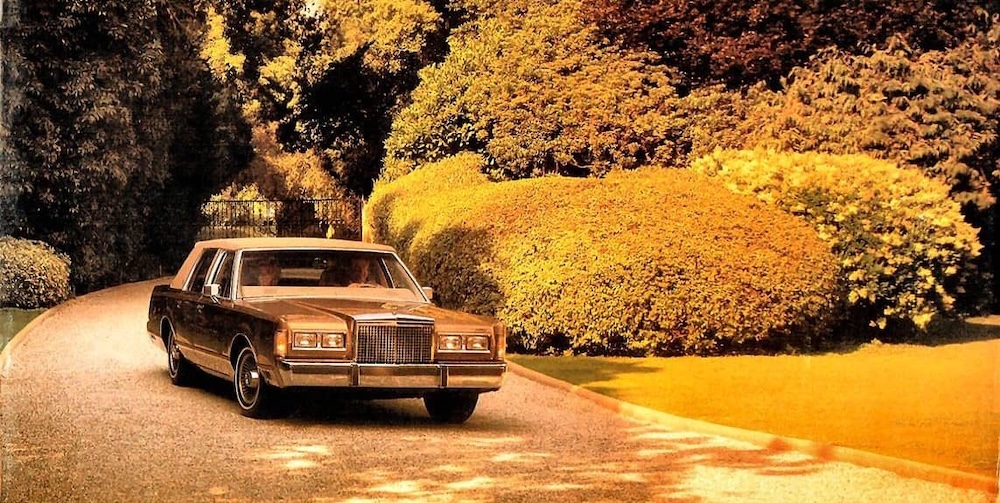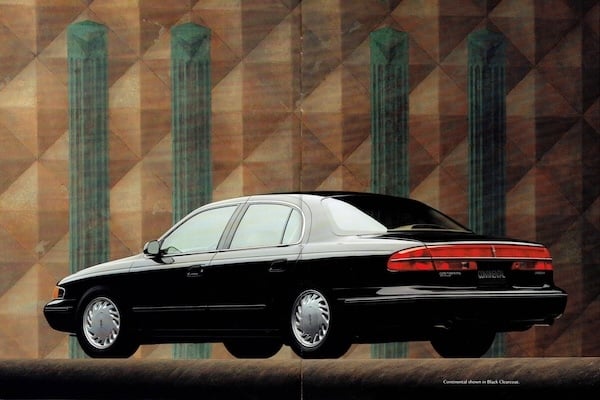When you think of American motoring excess, few images come to mind more than an American Land Yacht – most likely built by one of the Big 3 – gliding silently down an endless interstate. The subject this time is the Lincoln Town Car – one of the last of the great American sedans. Packed with high technology for its time and roaring down the highway like a river in full flow, the Town Car is a symbol of American automotive culture that other markets never truly managed to replicate.
The Town Car name wasn’t always attached to its own model. In the postwar era, it was simply a trim level for the Lincoln Continental. That changed in 1981, when Lincoln spun off the Town Car into a standalone model. The timing couldn’t have been more symbolic: Ford Motor Company, Lincoln’s parent, had just ended production of the enormous 5.9-metre Lincoln Continental in 1979 – the last of the truly massive American sedans – while rivals at General Motors had already downsized their big cars years earlier due to tightening fuel economy and safety regulations.The Town Car became Ford’s answer to changing times, and it would prove to be one of the most important models in Lincoln’s history.
The Panther Platform and a Golden Era
The new Town Car rode on Ford’s Panther platform, shared with the Ford Crown Victoria and Mercury Grand Marquis. At first, it wasn’t obvious that this was a recipe for success. But with oil prices rising and Washington applying pressure, American carmakers were forced into drastic restructuring.
General Motors responded by experimenting with expensive, complicated engine technologies, pouring vast sums into advanced projects that struggled to pay off. Their new designs suffered from reliability issues, and GM’s once-proud divisions ended up selling cars that looked and felt nearly identical to one another. Cadillac customers could barely be convinced why they were paying more for a car that seemed little different from a Buick or an Oldsmobile.
Ford, meanwhile, stuck to its guns. The Panther cars were traditional body-on-frame sedans, simple to build and simple to maintain. And while Ford also developed modern, fuel-efficient cars like the Taurus, Probe and Escort for the future, it never abandoned the classic American full-size sedan. The strategy worked brilliantly.
By 1986, Town Car sales had exploded from just over 31,000 units in 1981 to nearly 120,000. These sales funded Ford’s development of icons like the Mustang and Thunderbird. Cadillac with the Fleetwood, hobbled by fragile engines and confused brand positioning, could only watch from the sidelines as Lincoln became the face of traditional American luxury.
A Symbol of American Grandeur
Why did it work so well? Because the Town Car embodied something deeply American. It was a car built for vast highways, for long-distance travel and for comfort above all else. It was tall, wide and unapologetically long. Its frame was mounted on thick rubber bushings to absorb vibration. Its interior was a sea of soft materials and heavy upholstery.
The design exaggerated its size further: long, sharp creases mimicked the pressed lines of a tailored suit, while the blunt nose, massive rear and vinyl Landau roof projected status. In fact, the Town Car was the most spacious six-passenger sedan sold in America during the 1980s. At 5.4 metres in length, it was as long as a standard Mercedes-Benz Sprinter van. The Town Car was built for Americans, by Americans – and in that simplicity lay its charm.
Technology Meets Tradition
Climb inside, and the Town Car surprised even the sceptics. Pulling on the door handle in the dark would activate courtesy lighting, illuminate the ignition key slot and light up the Opera lamps on the central pillar. The cabin greeted you with a blend of traditional velour upholstery and modern technology.
Signature Series models offered features that, in the 1980s, felt like science fiction. Digital green instrument displays, trip computers, auto-dimming headlights, power trunk closers, automatic climate control, JBL or Ford Premium sound systems, even keyless entry via a keypad on the driver’s door. Options included heated mirrors, six-way adjustable power seats with memory, additional seat padding, and air suspension on the rear axle. Some models could even be ordered with a built-in radio telephone.
The electronics went further: the parking brake released automatically when Drive was engaged, headlights switched themselves on or off depending on conditions, and the rear-view mirror dimmed automatically. The Town Car was rivaling Cadillac and even European brands in gadgetry.
Behind the Wheel
From the driver’s seat, the world looked distant across the long hood. Start the engine, and the instruments glowed green. Slide the column shifter into Drive, and the car eased forward with remarkable smoothness. Under the hood was Ford’s venerable 5.0-litre V8 – the famous “Five-Oh.” With electronic fuel injection, it produced around 150 horsepower. That figure wasn’t breathtaking, but the engine’s real gift was torque, delivered in a silent, vibration-free wave. The suspension was tuned for maximum isolation, with forgiving springs, massive bushings and soft mounts that made the Town Car float over the road like molten lava slipping across rock.
The steering, assisted by a strong power setup, was vague yet effortless. Braking was surprisingly powerful, thanks to a large dual-diaphragm booster. Compared to rivals like the Cadillac Brougham, the Lincoln felt more solidly built, quieter and more refined. Driving a Town Car was less about precision and more about presence. It swayed, it floated, and sometimes the body would roll comically if you yanked the wheel too hard. But that was part of its charm. Nothing else moved down the road quite like it.
A Lost Luxury
Today, cars like the Lincoln Town Car hold a special place in enthusiasts’ hearts. Once dismissed as outdated and comical in their Americana, they are now seen with nostalgia and warmth. Their simplicity, comfort and unapologetic excess are qualities modern cars rarely capture. In Europe, no true equivalent ever existed. Mercedes-Benz sedans were prestigious, but they were designed for autobahns, not for endless, cushiony comfort. Opel once experimented with its KAD series, but their lack of popularity proved Europeans never truly wanted such machines. The Town Car represented a kind of primal luxury – iron and steel wrapped in velour, designed purely for comfort and long-haul ease. It was both an art form and a technology that America has since abandoned.
Yet for all its grandeur, the Town Car was also a victim of its own excess. Its sheer bulk made it cumbersome in city traffic, the wallowy suspension dulled any sense of driver engagement. Fuel economy was predictably dismal, and while the gadgetry was impressive in its day, much of it now feels fragile and gimmicky. To younger drivers raised on taut European sedans, the Town Car can come across less as a symbol of luxury and more as a relic of a bygone mindset – a machine engineered for comfort at all costs, even if that meant abandoning dynamism, efficiency, or modern restraint.
For Europeans, it remains an exotic curiosity. For Americans, it was a familiar friend, a rolling living room, a vehicle that asked nothing more of its driver than to sit back and let the miles disappear beneath its vast body. The Town Car may be gone, but for those who appreciate its qualities, it will never be forgotten. It was a kind of performance art in steel and fabric and a genre of carmaking that has now expired.
---
Start your adventure by exploring our wide range of Car Categories. Then, step into the Classic Passion Shop and discover unique products from our partners — must-haves for every true enthusiast looking to elevate their collection!

















